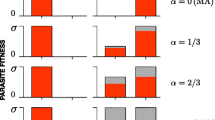Summary
Computer simulations of coevolutionary dynamics between two hosts and two parasites show that extensive spatial variation in polymorphism can be maintained among environmentally identical patches. Spatial variation can be maintained under frequent migration when the dynamics within patches are locally unstable, and the cycles in host and parasite abundances remain out of phase among patches. Additionally, spatial variation can be maintained when host-parasite interactions cause local extinctions, and migration subsequently allows for recolonization. The temporal dynamics that cause spatial variation are difficult to study directly because of the long time scale over which they occur. The simulations suggest that sampling over space at one or a few points in time may provide much information about temporal dynamics.
Similar content being viewed by others
References
Bennett, R. J. (1979)Spatial Time Series. Pion, London.
Burdon, J. J. (1987)Diseases and Plant Population Biology. Cambridge University Press, Cambridge.
Charlesworth, D. (1981) A further study on the problem of the maintenance of females in gynodioecious species.Heredity 46, 27–39.
Crow, J. F. (1979) Genes that violate Mendel's rules.Sci. Am. 240(2), 134–44.
Crow, J. F. and Kimura, M. (1970)An Introduction to Population Genetics Theory. Burgess Publishing Co., Minneapolis, USA.
Darwin, C. (1984)The Structure and Distribution of Coral Reefs. University of Arizona Press, Tucson.
Delannay, X., Gouyon, P.-H. and Valdeyron, G. (1981) Mathematical study of the evolution of gynodiecy with cytoplasmic inheritance under the effect of a nuclear restorer gene.Genetics 99, 169–81.
Endler, J. A. (1977)Geographic Variation, Speciation, and Clines. Princeton University Press, Princeton, New Jersey, USA.
Frank, S. A. (1989) The evolutionary dynamics of cytoplasmic male sterility.Am. Nat. 133, 345–76.
Frank, S. A. (1991a) Ecological and genetic models of host-pathogen coevolution.Heredity (in press).
Frank, S. A. (1991b) Divergence of meiotic drive-suppression systems as an explanation for sex-biased hybrid sterility and inviability.Evoluation (in press).
Gouyon, P.-H. and Couvet, D. (1985) Selfish cytoplasm and adaptation: variation in the reproductive system of thyme.Verh. K. Ned. Akad. Wet. Afd. Natuurkd. Tweede Reeks 85, 299–319.
Guckenheimer, J. and Holmes, P. (1983)Nonlinear Oscillations, Dynamical Systems, and Bifurcations of Vector Fields. Springer-Verlag, New York, USA.
Hamilton, W. D. (1967) Extraordinary sex ratios.Science 156, 477–88.
Hamilton, W. D. (1980) Sex versus non-sex versus parasite.Oikos 35, 282–90.
Hamilton, W. D. (1982) Pathogens as causes of genetic diversity in their host populations. InPopulation Biologi of Infectious Diseases (R. M. Anderson and R. M. May, eds) pp. 269–96. Springer-Verlag, New York.
Hamilton, W. D. (1986) Instability and cycling of two competing hosts with two parasites. InEvolutionary Processes and Theory (S. Karlin and E. Nevo, eds) pp. 645–68. Academic Press, New York.
Hanski, I. (1989) Metapopulation dynamics: does it help to have more of the same?TREE 4, 113–4.
Hartl, D. L. and Hiraizumi, Y. (1976) Segregation distortion. InThe Genetics and Biology of Drosophila, Vol. 1B. (M. Ashburner and E. Novitski, eds) pp. 615–66. Academic Press, New York.
Hassell, M. P. and May, R. M. (1989) The population biology of host-parasite and host-parasitoid associations. InPerspectives in Ecological Theory (J. Roughgarden, R. M. May and S. A. Levin, eds) pp. 319–47. Princeton University Press, Princeton.
Hastings, A. (1977) Spatial heterogeneity and the stability of predator-prey systems.Theor. Pop. Biol. 12, 37–48.
Hilborn, R. (1975) The effect of spatial heterogeneity on the persistence of predator-prey interactions.Theor. Pop. Biol. 8, 346–55.
Hurst, L. and Pomiankowski, A. (1991) A new explanation of Haldane's rule: causes of sex-ratio bias within species may also account for unisexual sterility in species hybrids.Genetics (submitted).
Kimura, M. and Weiss, G. H. (1964) The stepping stone model of population structure and decrease of genetic correlation with distance.Genetics 49, 561–76.
Lenski, R. E. (1988) Dynamics of interactions between bacteria and virulent bacteriophage.Adv. Microbiol. Ecol. 10, 1–44.
Lenski, R. E. and Levin, B. R. (1985) Constraints on the coevolution of bacteria and virulent phage: a model, some experiments, and predictions for natural communities.Am. Nat. 125, 585–602.
Levin, B. R. and Lenski, R. E. (1983) Coevolution in bacteria and their viruses and plasmids. InCoevolution. (D. J. Futuyma and M. Slatkin, eds) pp. 99–127. Sinauer, Sunderland, Massachusetts.
Levin, B. R. and Lenski, R. E. (1985) Bacteria and phage: a model system for the study of the ecology and co-evolution of hosts and parasites. InEcology and Genetics of Host-Parasite Interactions. (D. Rollinson and R. M. Anderson, eds) pp. 227–42. Academic Press, New York.
Levins, R. and Culver, D. (1971) Regional coexistence of species and competition between rare species.Proc. Natl. Acad. Sci. USA 68, 246–8.
May, R. M. (1973)Stability and Complexity in Model Ecosystems. Princeton University Press, Princeton.
Maynard Smith, J. (1974)Models in Ecology. Cambridge University Press, Cambridge.
Parker, M. A. (1989) Disease impact and local genetic diversity in the clonal plantPodophyllum peltatum.Evolution 43, 540–7.
Pickett, S. T. A. (1989) Space-for-time substitution as an alternative to long-term studies. InLong-Term Studies in Ecology. (G. E. Likens, ed.) pp. 111–35. Springer-Verlag, New York.
Pimm, S. L. and Gilpin, M. E. (1989) Theoretical issues in conservation biology. InPerspectives in Ecological Theory. (J. Roughgarden, R. M. May and S. A. Levin, eds) pp. 287–305. Princeton University Press, Princeton.
Sabelis, M. W. and Diekmann, O. (1988) Overall population stability despite local extinction: the stabilizing influence of prey dispersal from predator-invaded patches.Theor. Pop. Biol. 34, 169–76.
Schmitt, J. and Antonovics, J. (1986) Experimental studies of the evolutionary significance of sexual reproduction. IV. Effects of neighbor relatedness and aphid infestation on seedling performance.Evolution 40, 830–36.
Slatkin, M. (1974) Competition and regional coexistence.Ecology 55, 128–34.
Slatkin, M. (1985) Gene flow in natural populations.Ann. Rev. Ecol. Syst. 16, 393–430.
Wright, S. (1969)Evolution and the Genetics of Populations, Vol. 2. University of Chicago Press, Chicago.
Zeigler, B. P. (1977) Persistence and patchiness of predator-prey systems induced by discrete event population exchange mechanisms.J. Theor. Biol. 67, 687–713.
Zimmering, S., Sandler, L. and Nicoletti, B. (1970) Mechanisms of meiotic drive.Ann. Rev. Genet. 4, 409–36.
Author information
Authors and Affiliations
Rights and permissions
About this article
Cite this article
Frank, S.A. Spatial variation in coevolutionary dynamics. Evol Ecol 5, 193–217 (1991). https://doi.org/10.1007/BF02270834
Issue Date:
DOI: https://doi.org/10.1007/BF02270834




